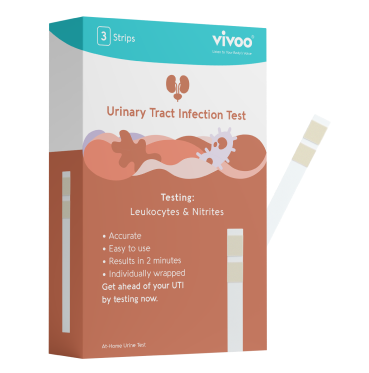A urinary tract infection (UTI) typically occurs when bacteria enter the urinary tract through the urethra, causing widespread inflammation. Infection that occurs only in the bladder is known as "cystitis". However, if the infection spreads to the kidneys and upper urinary canal, the condition will be known as "pyelonephritis". Of these two, cystitis is more easily treated. The most common symptom of a UTI is a burning sensation during and after urination. Other symptoms include frequent urination, incomplete urination, discomfort and swelling in the lower abdomen, cloudy and foul-smelling urine.
Urinary tract infections can damage the kidneys when treated incorrectly or late. Although many cases of UTI resolve spontaneously without treatment, many people still seek treatment for symptoms. Treatment for urinary tract infections aims to prevent the spread of infection to the kidneys, destruction of the delicate structures in the nephron, and the development of upper tract disease/pyelonephritis.

What is UTI?
UTIs typically occur when bacteria – microorganisms like proteus, Klebsiella, Enterococcus, and E. coli in particular – enter the urinary tract through the urethra (i.e., the tube that carries urine out of the body), then multiply in the bladder. A UTI can affect any part of the urinary system, including the urethra, ureters, bladder, and kidneys. One of the first few symptoms of a UTI is experiencing a burning sensation during urination.
Healthy individuals do not carry organisms such as bacteria, virus organisms, or fungi in their urine. Instead, the bacteria in question typically originates from external sources (e.g., anus) or the digestive tract. Anyone can get a UTI, but they are more common in women who’re known to have a 50% lifetime risk of the condition. This is because the urethra in women is shorter and closer to the anus, where E. coli bacteria is common. In other words: bacteria have a “shortcut” to reaching the bladder in women, significantly increasing the likelihood of a UTI.
Incidence of UTI
Urinary tract infections are common. UTIs cause more than 8.1 million visits to healthcare providers – and affect more than 150 million people worldwide yearly. In addition, more than 50% of women experience a UTI in their life.
Urinary tract infections are ranked the fifth most prevalent type of infection associated with healthcare services. A 2015 case study estimated that 9.5% of diagnosed infections, or 62,700 diagnoses, in acute care hospitals were UTIs.
Symptoms
Some patients show symptoms typical of a UTI – painful and/or burning sensation during urination. But it’s also worth noting that a urinary tract infection can manifest as a wide range of signs and symptoms. Moreover, UTIs may be overlooked or mistaken for other conditions in some instances (particularly when older individuals are involved).

Symptoms of urinary tract infection include:
- Frequent urination
- Pain or burning when urinating
- Fever
- Tiredness
- Dark, cloudy, or reddish urine indicates that blood may be present in the urine
- Foul-smelling urine
- Pelvic pain, especially in women
- Back or side pain under the ribs
- Nausea and vomiting
- Urinating only a tiny amount despite the feeling of urgency
Causes
Bacteria (specifically, intestinal bacteria of the Escherichia coli type found in human feces) is the primary cause of urinary tract infections. That said, sexually transmitted pathogens, viruses, or fungi could also cause UTIs. Since women's urinary tract opens with a very short channel, it is "easier" for microbes to enter from the outside. Uropathogens, mainly found in the vaginal and anal regions, can quickly spread upward into the urinary tract and bladder. The resulting entry and multiplication of bacteria within the bladder lead to infections.
UTIs are more likely to occur when the body's immunity is weakened. Other conditions that may increase your susceptibility to UTIs include exposure to wet environments (e.g., going to the pool, using the sauna, or going to the sea) or genital discharge that comes into contact with the urinary system.
Other causes also include:
- Sexual intercourse
- Poor hygiene
- Diabetes
- Pregnancy
- A previous UTI
- Exposure of the genitals to bacteria
- Obstruction in the urinary tract
- Prostate enlargement and kidney stones
- A weakened immune system
Health Risks
Although many cases of UTI resolve spontaneously without any medical treatment, it is still advisable to seek treatment when symptoms arise. Recurrent UTIs should not be expected to go away on their own. Left untreated, a UTI may lead to a more serious infection, such as an infection in the kidneys, where the damage might be irreversible. Long-term drug treatments might be required if the infection progresses and is left untreated.

How to detect a UTI
Some tests used to diagnose urinary tract infections include:
- Urine test (Microscope and Strip Tests)
- Urine Culture
- Cystoscopy
- Kidney and Bladder Ultrasound
- Computed Tomography (CT)
Can I take a home test for UTI
UTIs can be diagnosed several different ways – and while most of them traditionally require a visit to a lab, recent technology advancements have made at-home testing possible (through urine test strips). Urinalysis entails testing the urine for specific substances that could signal the presence of a UTI. These substances may include white blood cells (WBC) and nitrites.
The reason why white blood cells (specifically, leukocytes) are present in urine during a UTI is that your body uses WBC to fight off infections. As for nitrites: your body converts nitrate to nitrite present in urine only when there's an infection in the urinary tract – as a defense mechanism. So, the presence of nitrites in your urine is a strong indicator of a UTI.
Vivoo offers you a straightforward, fuss-free, and low-cost method of monitoring your urinary leukocytes and nitrites level – alerting you to any potential risk of UTIs in real-time. Vivoo also provides personalized lifestyle and nutrition advice that could even help you prevent or treat (mild) UTIs.
How does Vivoo detect a UTI?
Vivoo determines your likelihood of having a UTI by analyzing your urine sample for the two microorganisms mentioned earlier (i.e., leukocytes and nitrites). Its nature as an at-home urine test strip means you can detect UTIs – if present – very quickly and promptly. This allows you to make the necessary lifestyle and/or nutritional changes and seek professional medical help in the condition's early stages.
What to do prevent and treat UTI
Things you could do to reduce your risk of getting a UTI to include:
- Consuming plenty of water
- Avoiding holding in of pee for extended periods·
- Cleaning after going to the toilet (from front to back)
- Cleaning the genital area before and after sexual intercourse
- Urinating after sexual intercourse
- Avoiding the use of soap when cleaning the genital area
- Changing sanitary pads frequently
- Wearing cotton underwear and avoiding tight-fitting clothing
Some research suggests that certain foods may help support UTI recovery (e.g., when dealing with cystitis). Examples include cranberries and probiotics (e.g., yogurt and kefir).
Vivoo and UTI management
Vivoo strip tests allow you to detect the presence of UTIs quickly – and right from the comforts of your house. This will enable you to take prompt action, which is crucial in preventing further progression of the condition (which could cause irreversible damage to your urinary system). Better still: Vivoo also provides personalized lifestyle and nutritional advice that may help with recovery from UTIs (mild cases) and prevent the occurrence of future infections.













